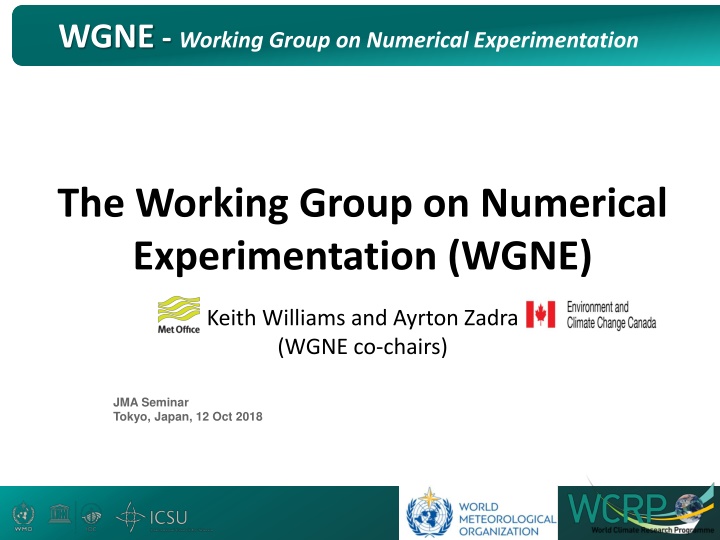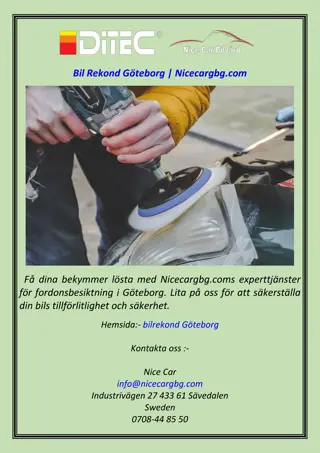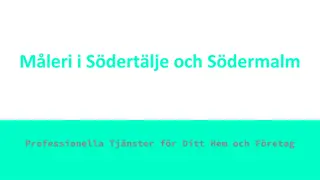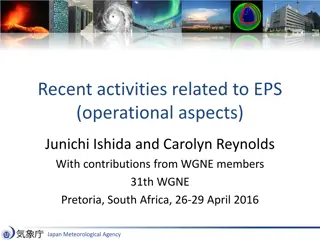
WGNE Working Group on Numerical Experimentation Activities Snapshot
Explore the insightful activities of the WGNE Working Group on Numerical Experimentation, focusing on fostering atmospheric circulation model development, diagnosing shortcomings, and collaborating on resolving systematic errors and parametrization projects. Discover their pioneering efforts in weather prediction and climate studies over the past 30 years.
Download Presentation

Please find below an Image/Link to download the presentation.
The content on the website is provided AS IS for your information and personal use only. It may not be sold, licensed, or shared on other websites without obtaining consent from the author. If you encounter any issues during the download, it is possible that the publisher has removed the file from their server.
You are allowed to download the files provided on this website for personal or commercial use, subject to the condition that they are used lawfully. All files are the property of their respective owners.
The content on the website is provided AS IS for your information and personal use only. It may not be sold, licensed, or shared on other websites without obtaining consent from the author.
E N D
Presentation Transcript
WGNE - Working Group on Numerical Experimentation The Working Group on Numerical Experimentation (WGNE) Keith Williams and Ayrton Zadra (WGNE co-chairs) JMA Seminar Tokyo, Japan, 12 Oct 2018
WGNE - Working Group on Numerical Experimentation fostering the development of atmospheric circulation models for use in weather prediction and climate studies on all time scales, and diagnosing and resolving shortcomings. Cases of strong or persistent events of aerosol pollution studied by the WGNE Aerosols project Objectives are achieved through Identification of systematic errors common to many models. Sharing diagnostic tools and techniques to get to the root of the error. Sharing knowledge around sensitivity of errors to model formulation (parametrizations, dynamical core, etc.). Work with other groups (e.g. GASS & GLASS) to develop solutions. MJO - Task Force: Real time MJO Index forecast activity using 20 forecast models
WGNE - Working Group on Numerical Experimentation fostering the development of atmospheric circulation models for use in weather prediction and climate studies on all time scales, and diagnosing and resolving shortcomings. WGNE has existed for over 30 years WCRP Joint Scientific Committee (JSC) WGNE reports to both WMO Commission for Atmospheric Sciences (CAS) CAS WGNE has been a pioneer of seamless work (e.g. developing the AMIP and Transpose-AMIP methodologies)
WGNE - Working Group on Numerical Experimentation WGNE activities over recent years Routine model evaluation/verification MJO-Task Force YoTC Transpose-AMIP High-Res MIP WGNE-WGCM Climate Metrics and Diagnostics Panel Grey Zone DCMIP JWGFVR WGNE Table of supercomputing development Links to other groups WGNE Workshops on Systematic Errors Drag Project Aerosols Project Parametrization development
WGNE - Working Group on Numerical Experimentation WGNE activities over recent years MJO-Task Force YoTC Parametrization projects since 2009, WGNE has had an increased focus on parametrization development in models sharing knowledge of sensitivities and different approaches close working relationship with GEWEX GASS and GLASS is important WGNE hopes to continue to strengthen this in the future with more joint projects on parametrization development, targeting common systematic errors Transpose-AMIP High-Res MIP Grey Zone DCMIP WGNE Table of supercomputing development Drag Project Aerosols Project Parametrization development
WGNE - Working Group on Numerical Experimentation WGNE activities over recent years WGNE MJO-Task Force goal is to improve the representation and the predictive skill of the MJO and related phenomena in weather and climate models 5 sub-projects: i) Process-orientated diagnostics ii) Evaluation of real time forecasts iii) Assessment of intraseasonal variability in CMIP models iv) Joint MJO-TF GASS diabatic processes experiment v) Investigation of MJO air-sea interaction in the coming years, focus will be around o propagation of the MJO across the Maritime Continent region o teleconnections with other parts of the tropics and mid-latitudes. MJO-Task Force YoTC Transpose-AMIP High-Res MIP Grey Zone DCMIP WGNE Table of supercomputing development Drag Project Aerosols Project Parametrization development
WGNE - Working Group on Numerical Experimentation WGNE activities over recent years MJO-Task Force YoTC WGNE Grey Zone project o set up with GASS. Initial project focussed on a cold air outbreak case. o investigate the possible development of scale-aware schemes to operate through these grey zones . o continued work on this project is seen as a priority. o Although initially considering deep convection, also need to consider grey zones for other processes. o GASS Grey Zone II white paper has been proposed by Tomassini et al. Transpose-AMIP High-Res MIP Grey Zone DCMIP WGNE Table of supercomputing development Drag Project Aerosols Project Parametrization development
WGNE - Working Group on Numerical Experimentation WGNE activities over recent years WGNE Drag Project to explore the parametrized component of surface stress and its partitioning between schemes (e.g. PBL, sub-grid orography). found to vary significantly between models; notable impact on circulation & predictability Following the 2016 ECMWF / WCRP / WWRP workshop on drag processes (partly supported by SPARC / WGNE / GASS), 3 main areas of research were identified: i) better theoretical understanding ii) better understanding of inter-model differences iii) use high-res simulations + observations + new techniques to understand model errors and improve/constrain representation of drag in models. MJO-Task Force YoTC Transpose-AMIP High-Res MIP Grey Zone DCMIP WGNE Table of supercomputing development Drag Project Aerosols Project Parametrization development
WGNE - Working Group on Numerical Experimentation WGNE activities over recent years MJO-Task Force WGNE Aerosols Project investigation into the role of aerosols in short range weather forecasting building on the findings in the climate community of the importance of fully interactive aerosols in model simulations key challenge: real-time initialisation of the aerosols project showed some limited benefits however these may be more considerable in extended forecasts => WGNE is partnering with S2S to extend the experiment to seasonal predictions YoTC Transpose-AMIP High-Res MIP Grey Zone DCMIP WGNE Table of supercomputing development Drag Project Aerosols Project Parametrization development
WGNE - Working Group on Numerical Experimentation WGNE activities over recent years Model evaluation key activity of WGNE is the routine evaluation and verification of models traditionally this has been in terms of outcome metrics of model performance such as those overseen by CBS (e.g. forecast root-mean-square-error of 500hPa geopotential height) sometimes hard to go from these metrics to identifying errors in model processes WGNE is increasingly considering more process-orientated metrics and diagnostics such as o tropical cyclone track and intensity errors o precipitation errors in terms of intensity, structure, location, timing, etc. Routine model evaluation/verification WGNE-WGCM Climate Metrics and Diagnostics Panel JWGFVR Links to other groups WGNE Workshops on Systematic Errors
WGNE - Working Group on Numerical Experimentation WGNE activities over recent years WGNE-WSE identification of systematic errors amongst weather and climate models WGNE has organised 5 well attended workshops on Systematic Error1: 1st Toronto, 1998 2nd Melbourne, 2000 3rd San Francisco, 2007 4th Exeter, 2013 5th Montreal, 2017 bringing weather and climate communities together to discuss common issues E.g. an outcome from the 2013 WGNE-WSE was the need to focus on surface fluxes, especially over the oceans and polar regions. Since then a number of field campaigns (e.g SOCRATES Southern Ocean and Year(s) of Polar Prediction campaigns) have made this a priority Routine model evaluation/verification WGNE-WGCM Climate Metrics and Diagnostics Panel JWGFVR Links to other groups WGNE Workshops on Systematic Errors
WGNE - Working Group on Numerical Experimentation 5thWGNE Workshop on Systematic Errors (WSE) Zadra et al. (2017) Systematic Errors in Weather and Climate Models: Nature, Origins, and Way Forward. BAMS. https://doi.org/10.1175/BAMS-D-17-0287.1 Themes: Atmosphere-land-ocean-cryosphere interactions: errors in the representation of surface fluxes and drag processes; stable boundary layer issues; impact of coupled modeling. Clouds and precipitation: cloud-radiative feedback problem; tropical convection issues; representation of low clouds, especially at high latitudes; excess low accumulations of precipitation; underestimation of precipitation extremes; summer continental precipitation; precipitation over orography. Resolution issues: dependence of systematic errors on model resolution; grey zones of physical parametrizations. Teleconnections: errors in the simulation of interactions between high-latitudes, mid-latitudes and tropics. Metrics and diagnostics: emphasis on novel techniques (e.g. process-based diagnostics; use of data assimilation or coupled modeling) to diagnose and measure systematic errors. Model errors in ensembles: characterization of ensemble spread and identification of systematic errors in multi-model ensembles and ensemble prediction systems; evaluation of stochastic representations.
WGNE - Working Group on Numerical Experimentation Summary of key systematic errors from the 5thWGNE WSE: Convective precipitation (diurnal cycle, organisation of convective systems, precipitation intensity distribution, relationship with CWV, SST, Omega, MSE, etc.). MJO propagation across the MC, response to mean errors & teleconnections elsewhere. Sub-tropical boundary layer cloud (too little, too bright) and their variation with large scale parameters (SST, EIS, Omega, etc.). Can have a coupled component/feedback (upwelling, evap., etc.). Double ITCZ/ENSO possibly a complex combination of ENSO extension, cloud-ocean interaction, representation of TIWs. Cloud microphysics especially mixed-phase, supercooled liquid cloud and warm rain. Precipitation over orography distribution and intensity. Fog and low-based cloud no systematic errors identified but is hard to forecast. Tropical cyclones sometimes too intense at high resolutions. Wind-pressure relationship errors. Biases, variability and predictability of large-scale dynamics very sensitive to surface drag. CMIP5 mean circulation errors consistent with too little drag. Representation of the heterogeneity of the soil. Current stochastic physics schemes, whilst beneficial, don t necessarily sufficiently capture all aspects of model uncertainty. Surface turbulent and radiative flux errors (incl. surface wind stress, evaporation, etc.). Diurnal cycle of surface temperature. Variability and trends in historical external forcings. Mid-latitude synoptic regimes and blocking. Teleconnections through the stratosphere. To do: Prioritise this list
WGNE - Working Group on Numerical Experimentation Recommendations from 5thWGNE WSE: Extend drag project to consider momentum more generally and consider representation of orography, etc. Consider setting up a group or extend drag group to look at surface flux errors. More research is required on how to represent model uncertainty. Encourage community to make use of S2S drifts database. Discuss with S2S/WGSIP regarding extension of aerosols project to seasonal timescale. Consider a cross weather-climate group looking at initial tendency analysis of common biases. Hold another WSE in 4-5 years time, possibly inviting submissions on solutions rather than just problems.
WGNE - Working Group on Numerical Experimentation Recommendations from 5thWGNE WSE: Extend drag project to consider momentum more generally and consider representation of orography, etc. Consider setting up a group or extend drag group to look at surface flux errors. More research is required on how to represent model uncertainty. Encourage community to make use of S2S drifts database. Discuss with S2S/WGSIP regarding extension of aerosols project to seasonal timescale. Consider a cross weather-climate group looking at initial tendency analysis of common biases. Hold another WSE in 4-5 years time, possibly inviting submissions on solutions rather than just problems. WGNE 32 agreed that the drag project should evolve into momentum project and SPARC have expressed an interest in being involved. Sandu et al. are leading a GASS white paper on Surface drag and momentum transport.
WGNE - Working Group on Numerical Experimentation Recommendations from 5thWGNE WSE: Extend drag project to consider momentum more generally and consider representation of orography, etc. Consider setting up a group or extend drag group to look at surface flux errors. More research is required on how to represent model uncertainty. Encourage community to make use of S2S drifts database. Discuss with S2S/WGSIP regarding extension of aerosols project to seasonal timescale. Consider a cross weather-climate group looking at initial tendency analysis of common biases. Hold another WSE in 4-5 years time, possibly inviting submissions on solutions rather than just problems. Francois Bouyssel (Meteo-France) and Carolyn Reynolds (NRL) are initiating a project on surface fluxes. Initial focus will be over oceans.
WGNE - Working Group on Numerical Experimentation Recommendations from 5thWGNE WSE: Extend drag project to consider momentum more generally and consider representation of orography, etc. Consider setting up a group or extend drag group to look at surface flux errors. More research is required on how to represent model uncertainty. Encourage community to make use of S2S drifts database. Discuss with S2S/WGSIP regarding extension of aerosols project to seasonal timescale. Consider a cross weather-climate group looking at initial tendency analysis of common biases. Hold another WSE in 4-5 years time, possibly inviting submissions on solutions rather than just problems. WGNE meet with PDEF this week with a key aim to discuss a joint project on model uncertainty (possibly starting with coarse graining).
WGNE - Working Group on Numerical Experimentation WGNE is the sum of its members and exofficios We ask all members to play an active role and contribute (e.g. by leading/participating in projects) Thank you to all the WGNE members for the work you do



